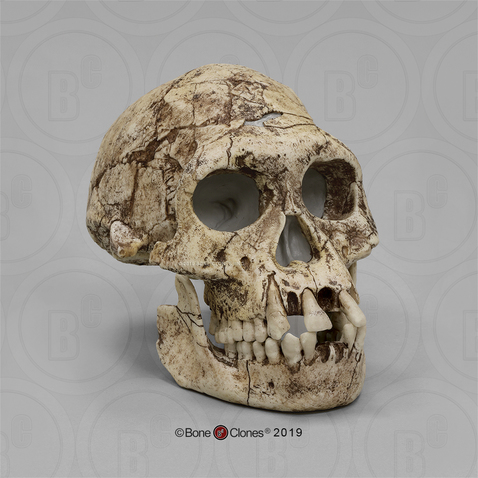-
Fields of Study
- K-12 Education
- Advanced Anatomy
- Forensics
- Physical Therapy
- Primate Locomotion
- Non-primate Locomotion
- Biological Anthropology
- Paleontology
- Bioarchaeology
- Marine-Aquarium
- Veterinary
-
Zoology
- All Zoological Items
- Endangered Species
- Skulls
- Skeletons
- Cranial Elements
- Postcranial Elements
- Eggs
- Limbs
- Teeth & Fangs
- Claws & Talons
- Brains & Endocasts
- Life Casts
- Pathology & Trauma
- Wildlife Forensics
- Sets
- Bird Sets
- Accessories
- Birds
- Mammals
- Reptiles & Amphibians
- Fish
- Sharks & Rays
- Turtles & Tortoises
- Anatomy for the Artist
- Decor
- Veterinary
- Elements
- Pathology & Trauma
-
Sets & Series
- Natural History Gift Ideas
- Decor
- Scale & Sculpture
- 3D Scanned & Printed
- Bone Boxes
- Locomotion Sets
- Forensic Sets
- Advanced Anatomy Sets
- Physical Therapy Series
- Fetal Sets
- Economy Series
- Zoology Sets
- Bird Sets
- Claw & Talon Sets
- Tooth & Fang Sets
- Primate Skull Sets
- Fossil Hominid Sets
- B.I.O.P.S.I. - Babiarz Institute
- Maxwell Collection
- Bergdorf Goodman Windows
- Accessories
- New Products
-
Our Company
- News & Specials
- Printable Handouts
- About Us
- Why Choose Bone Clones
- Bone Clones in the News
- Mission
- Contact Us
- Privacy and Security
- FAQs
- Testimonials
- Community Outreach
- Legal/Copyright
- Flyers
- Choosing Original Specimens
- Museum Exhibitions
- Natural History Gift Ideas
- About the Economy Series
- Acknowledgements
- Ordering & Delivery
- Warranty
- Refund/Return Policy
- Price List at a Glance
- Our Catalog
- Osteological Evaluation Reports
- About 3D Printing
- Sawyer & Maley Neanderthal Reconstruction
- Site Introduction
- Newsletter Archive
-
Human Anatomy
- All Human Anatomy
- Human Skulls
- Human Skeletons
- Head & Neck
- Postcranial Elements
- Advanced Anatomy
- Physical Therapy / Joints
- Human Brains & Endocast
- Human Life Casts
- Maxwell Museum
- Sets & Series
- Accessories
- Osteological Evaluation Reports
- Featured
- Adult Human Anatomy
- Adolescent Human Anatomy
- Child Human Anatomy
- Fetal Human Anatomy
-
Zoology
- All Zoological Items
- Endangered Species
- Skulls
- Skeletons
- Cranial Elements
- Postcranial Elements
- Eggs
- Limbs
- Teeth & Fangs
- Claws & Talons
- Brains & Endocasts
- Life Casts
- Pathology & Trauma
- Wildlife Forensics
- Sets
- Bird Sets
- Accessories
- Birds
- Mammals
- Reptiles & Amphibians
- Fish
- Sharks & Rays
- Turtles & Tortoises
- Fossil Hominids
- Paleontology
- Non-human Primates
- Forensics
All items sold on this website are replicas; no real/natural bone is available on this site. Bone Clones® are 1:1 scale unless stated otherwise. All Bone Clones® products are made in the USA.
- Fossil Hominid ,
- Hominid Skull ,
- Ergaster ,
- Erectus ,
- Homo
 ALSO SEE:
ALSO SEE:
- Display Stand Only
- Dmanisi Homo erectus Skull 1
- Dmanisi Homo erectus Skull 2
- Dmanisi Homo erectus Skull 4
- Dmanisi Homo erectus Skull 5
- Fossil Hominid Skeletons
- Fossil Hominid Skulls
Homo erectus Dmanisi Skull 3
BH-055 $459.00
(Stand Sold Separately)
1.7 MYA. The Dmanisi site in the country of Georgia has yielded incredible hominin fossil finds of the species Homo erectus, adding further documentation to the presence of Homo existing outside of Africa around 1.7 million years ago during the Plio-Pleistocene period. This specimen is one of five individuals found in the same area and provides an incredible glimpse of early human development, within group variation, and hominin migration patterns.
Dmanisi D2700 (cranium)/D2735 (mandible) Homo erectus was discovered in 1999 by Abesalom Vekua, et al. in Dmanisi, Georgia. This small-brained specimen, found alongside Oldowan-like choppers and scrapers, undercuts the theory that hominids did not leave Africa until about one million years ago and only after becoming large-brained bipeds with well-developed tool-making abilities. The cranial capacity of D2700 (600 cc) is similar to that of the African H. habilis specimens. Despite their small cranial capacity, characteristics of the crania and mandibles show greater similarity to early African Homo erectus/ergaster than to Homo habilis. This specimen was found in good condition with minor taphonomic damage and indications of periodontal disease. This individual is estimated to be a sub-adult with partially erupted 3rd molars and unfused basioccipital and sphenoid. Since, this individual is young, sex can be difficult to establish. The generally gracile facial morphology indicates it may be female, while the presence of a large upper canine tooth and large zygomatic bones indicate this may be a male.
The Bone Clones® Fossil Hominid line is composed of discoveries from anatomically modern humans, archaic humans, early Homo, early hominins, and other hominids. The majority of the casts in this line have been recreated by our team of anatomical sculptors. Some are reconstructions made by anthropology professionals using fragmentary elements from original discoveries and extrapolating the missing parts from those (i.e. Neanderthal skeleton).
2-part skull (separate cranium & jaw).
Custom display stand available below.
Jaw available individually as well, please inquire.
| Scientific Name | Catalogue # | Size | Price |
| Homo erectus (ergaster) | BH-055 | 7 ¾" L x 5" W x 5 ¼" H 20.0L x 12.9W x 15.9H (cm) | $459.00 |
Related Products:
-
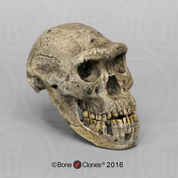 Homo erectus Dmanisi Skull 5
Homo erectus Dmanisi Skull 5 -
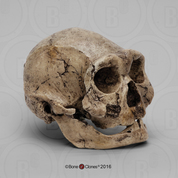 Homo erectus Dmanisi Skull 4
Homo erectus Dmanisi Skull 4 -
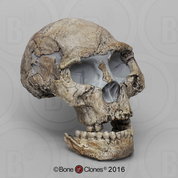 Homo erectus Dmanisi Skull 2
Homo erectus Dmanisi Skull 2 -
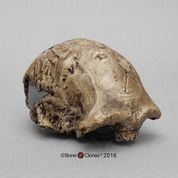 Homo erectus Dmanisi Skull 1
Homo erectus Dmanisi Skull 1 -
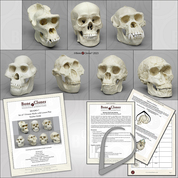 Set of 7 Primate Skulls with Lesson Plan
Set of 7 Primate Skulls with Lesson Plan -
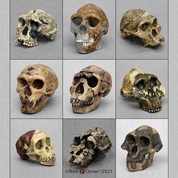 Set of 9 Fossil Hominid Skulls
Set of 9 Fossil Hominid Skulls -
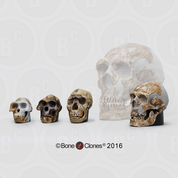 Set of 4 Hominid Skulls, Half Scale
Set of 4 Hominid Skulls, Half Scale -
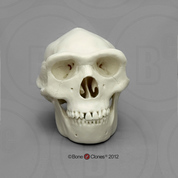 Homo erectus Skull, Half Scale
Homo erectus Skull, Half Scale -
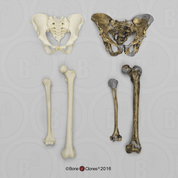 Neanderthal and Modern Human Comparative Pelvis, Femur, Humerus Set
Neanderthal and Modern Human Comparative Pelvis, Femur, Humerus Set -
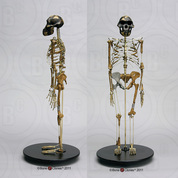 "Lucy" Skeleton, Articulated
"Lucy" Skeleton, Articulated -
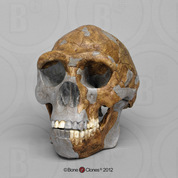 Homo erectus Skull - Tattersall-Sawyer Recreation
Homo erectus Skull - Tattersall-Sawyer Recreation -
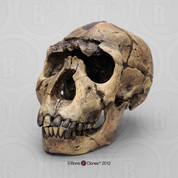 Homo ergaster Skull KNM-WT 15000
Homo ergaster Skull KNM-WT 15000 -
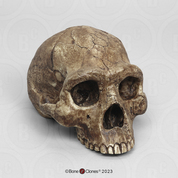 Homo erectus Economy Cranium
Homo erectus Economy Cranium -
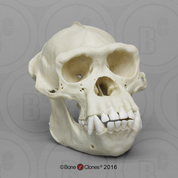 Chimpanzee Skull, Adult Male
Chimpanzee Skull, Adult Male -
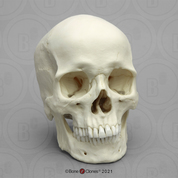 Human Male European Skull
Human Male European Skull
Newsletter Signup
9200 Eton Ave.
Chatsworth, CA 91311 USA
© 1992-2026 Bone Clones Holdings. All Rights Reserved.
Customer Service
© 2026 BONE CLONES HOLDINGS / Made by MEV




